
Standard Size & Dimension of Badminton Court
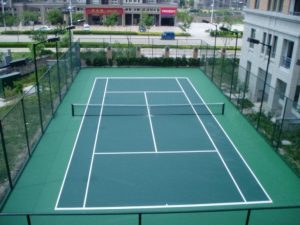
Badminton courts should have clear boundaries. The width of the court line is usually 40 mm, the color of the court line is white (preferably) , yellow or other easily distinguishable colors. All venue lines are parts of the area it defines. In a comprehensive gymnasium, there are often various line interference in different venues. Using different colors against the floor to paint off the boundaries will affect the badminton court significantly.
Within 12 meters above the court and within 2 meters around the court, there should be no obstacles (including two adjacent courts). If these requirements can`t be met due to the limitations of objective conditions, the organizer can negotiate with the various teams to make necessary amendments to the above requirements and make supplementary provisions, but it should meet the requirements of the rules for the stadium as far as possible.
Badminton matches are required to be played in a relatively bright environment. The lights above the court are an important factor related to the success of the game, because appropriate lights can make athletes feel confident in the game. In addition, when the players look at the ball towards the wall or ceiling, any reflective surface will interfere the players from hitting the badminton. To avoid interference from natural light, curtains should be hung on the top of the sports venue. In a dedicated court, the walls and ceiling should be dark. There are two methods for the setting and layout of the lights: one is an incandescent light bulb, which is installed over the net posts on both sides of each court (no need to install a reflection device), and the total light intensity should be between 400 and 500 lux, the other is fluorescent lamp, which is required to be placed parallel to the court’s sideline and the same length. In grassroots competitions, it is also possible to play outdoors or in the stadium using natural light as long as there is no wind interference.
Height of Badminton Court

According to international competition rules, the minimum space above the entire court is 9 meters, within this height, there should be no beams or other obstacles, and there should be no obstacles within 2 meters around the court. A minimum of 2 meters space between any two pitches side by side is also a must.
The badminton court is a rectangular field with a length of 13.40 meters, the doubles field is 6.10 meters wide, and the singles field is 5.18 meters wide. Each line on the court is 4 cm wide, measuring from the outer edge of the line. Course boundaries are best drawn in white, yellow or other easily recognizable colors.
The badminton net is 6.10 meters long and 0.76 m wide, making of high-quality dark natural or man-made fibers. The mesh size is between 15-20 mm, the top edge of the net should be stitched with a 75-wide double-layer white cloth), passing through the mezzanine with a thin steel wire rope or nylon rope, and hang it firmly between the two net posts.
Relationship Between Badminton Court Lighting and Height

The relationship between the height of the court and the light– How does the height of the fixtures affect the luminance of the arena? How high the general stadium lights need to be installed? The height of the stadium is different, so the lighting is different, and the actual lighting effect is different, too. In general, most of the stadiums around 3-6 meters use row lights, they can take care of the coverage of the row lights because the height is low, and the lower cost is also considered. Row lights are not recommended for badminton stadiums over 6 meters, on one hand, row lamps have a large light decay rate, short lamp lifespan, and high replacement frequency.
In addition, if to install row lamps in stadiums above 6 meters, the lights will effect the empty width of the stadium and reduce the grade of the stadium. For courts over 6 meters, chandeliers are recommended, but not all lights are suitable for chandeliers. There are many types of chandeliers, such as LED lamps, metal halide lamps, and electrodeless lamps. Many badminton players don’t like the starry layout of chandeliers, mainly because they feel that the chandeliers are too dazzling and they can’t see the badminton when they look up. This is the main reason why the stadiums use LED lights or metal halide lights as lighting source as LED lights and metal halide lights are point light sources.
Under strong light, prolonged contact will also damage the eyes. Therefore, it is generally recommended to use a chandelier when the stadium is more than 12 meters high. The strong light illuminates the stadium with high light coverage and high light illumination. For stadiums with a height of 6-12 meters, it is recommended to use induction lamps as pendant lamps, preferably low-frequency induction lamps. As a new type of lighting, electrodeless lamps use electrodeless beams without the trouble of electrodes and tungsten wires. They are surface light sources. Soft and bright lights reduce the stimulation of the eyes to a minimum, while low-frequency electrodeless lamps are not only glare-free, but also no flicker, and the lifespan is long.
Lighting Requirements for Badminton Court
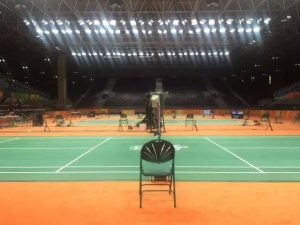
For badminton sports, a professional court is indispensable! For a modern court, not only should the buildings be beautiful and elegant, and all kinds of badminton equipment must be complete, also it should have a good lighting environment, that is, it requires appropriate, uniform illumination and brightness, ideal light color, three-dimensional sense and no Glare, etc. In addition to ensure good viewing results for the audience, the lighting requirements for referees, athletes, and events must also be guaranteed, as well as good television coverage.
Lighting is based on the function of fixtures to make sure that the light acts on the eyes of the players, referees and spectators, and produces vision so that everything on the ground of the badminton hall can be seen, such as the light and darkness of the venue environment, the color of the surface of objects, buildings, clothing, etc. The shape and size, depth, three-dimensionality of the target, the state of the players during exercise and the atmosphere of the badminton hall, etc. therefore, good lighting plays an important role in modern badminton courts.
How to design the Lighting for badminton court?
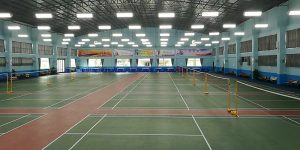
According to the characteristics of the indoor court lighting, the lighting quality goals of the indoor badminton court are as follows: on the whole, the court lights are like daylight, pure light color, bright and clear, the lights are stable, smooth, not fluctuating, and there is no stroboscopic effect. The badminton court lighting fixtures do not produce glare hazard.
Also it`s a must that the badminton flight trajectory in the air is real, no tailing, no ghosting, and true and accurate air positioning. Athletes play the ball accurately and stably, with visual comfort and no fatigue.
There are several items of lighting effects that badminton court lighting should achieve. However, from the practical point of view of sports and exercise, for the indoor courts of folk fitness exercises and leisure functions, it is not appropriate to use a one-size-fits-all rigid index. It can be determined by the investment operator within a reasonable range according to many technical and economic factors such as the investment and the playing level of the players.
Satisfaction is practical and practical is good. Many indoor courts lighting cases show that the indoor badminton hall lighting for civilian fitness functions can grasp the lighting quality, and its stadium lighting effect can reach a certain level, which can meet the requirements of playing sports.
In badminton court lighting, we use a unique light distribution technology, which has a 25% higher light efficiency than other ordinary LED lights, 144 light distribution curves, accurately controlled light, improving light utilization, and project the original as far as possible. The light effect is projected into the venue, which improves the lighting efficiency.
Badminton Court Lighting Design
1.Badminton court lighting-glare
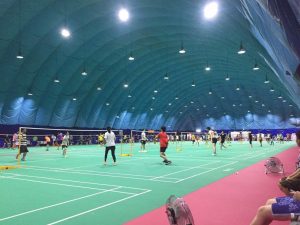
Glare refers to the visual conditions that cause visual discomfort and reduce the visibility of objects due to inappropriate brightness distribution in the field, or extreme brightness contrast in space or time. A bright feeling that human eyes can not adapt to in the field has a great impact on athletes, especially in badminton. If the lighting effect is not good, the athlete will not be able to determine the ball’s falling point accurately.
In order to ensure uniform illumination at all angles and prevent indoor glare, the elevation angle of the lowest point of the court to the lamps must be greater than 45 °, at which athletes or spectators can shot directly. Now badminton courts use computers to calculate light projection points to ensure uniform and reasonable distribution of light. Indoor glare can also be caused by different floor materials or water reflections from swimming venues, so grilles or baffles can also be added to the lamps to reduce glare.
2.Badminton court lighting-Light Distribution
The badminton court’s light distribution is scattered and is mainly divided into the viewing area and the competition area. However, because the athlete’s range of motion is not just a flat ground field, vertical lighting has a greater impact on athletes. This is because, while controlling the illumination of the lights reasonably, it is also necessary to plan the distribution of the lights reasonably, and to ensure the lighting requirements of the auditorium on the premise of ensuring the athletes’ competition.
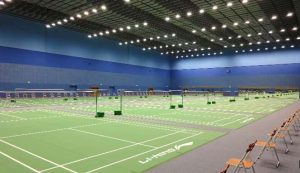 3. Badminton court lighting-light source characteristics
3. Badminton court lighting-light source characteristics
The degree to which a light source renders an object’s color is called Color Rendering Index, that is, the degree of color fidelity. A light source with high CRI reproduces the color better, and the color we see is closer to the natural primary color, while if the CRI is low, the light source has poor color reproduction, and the color deviation we see is threrfore large. The light source in the badminton court should ensure better color rendering and allow athletes to make more accurate judgments.
4. Badminton court lighting-selection of lamps
The choice of lamps is also very important for badminton games. A few years ago, the badminton court lighting was generally metal halide, but in the process of using, problems continued to cause considerable trouble for the badminton court! Frequent quality problems such as glare, external light, and heating of the lamps have seriously affected the performance of professional badminton games.
Since then, the courts have upgraded the lighting, replacing metal halide lamps with more advanced LED sports lighting. In the field of badminton court lighting, Huaxia Big Dipper has a unique position. It is understood that Huaxia Big Dipper is the first sports lighting company in China to provide large international sports events abroad. Before that, they appeared as lighting suppliers for the U20 Women’s World Cup!
Huaxia Beidouxing’s lighting fixture is a new generation of green lighting system, which minimizes the light pollution to the surrounding environment, prevents external light and glare effectively, minimizes the light shining outside the venue, protects the beautiful night sky, and provides athletes and spectators with enough luminance. The lighting of the badminton court creates a more comfortable playing and viewing environment.
5.Badminton court lighting-illumination
In addition to the reasonable illumination, the athletes can play normally and the referees can make accurate judgments. They can also ensure that the audience on the scene and in front of the TV can watch the game comfortably. Different sports also require different illumination levels. The illumination required for sports events, business activities, etc. also varies.
6.Badminton Court Lighting-Uniformity of Lighting
The ratio of the minimum illumination value to the maximum is the illumination uniformity, whether it is an indoor stadium or an open-air badminton court, the lighting requirements are very high. Taking badminton court as an example, the intermediate venues tend to gather more light, but areas with excessive light often produce glare, and some areas tend to have weaker light levels, ensuring the uniformity of the overall field lighting, which plays a vital role in the performance of athletes.
The Lights Used in Badminton Courts
Gold halogen lamps are currently used, but they consume pretty much power and require preheating. The most terrible thing is dazzling. Consider using a tube, LED or induction lamp. From the perspective of effect, energy consumption and price, which lamp should be used?
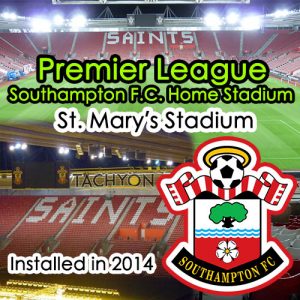
Five or six years ago or even three or four years ago, LED light source lights were not the first choice for badminton court special lights, and now many problems have been solved. For example, the lighting efficiency came up. Five years ago, the lamp 70LM / W may have a relatively higher light efficiency, while at present, 100 lumens per watt is more common. It even reachs 130, 140 or 150 lm/W. Another problem is dazzling, but now this problem has been solved by the senior engineers of Shenzhen Liangcan brand, which is a great improvement. Even if you saw them instantlyat the LED light source, you will also feel blinded. Furthermore, the concept of lamp design has become more advanced, which fully eliminates the factors that caused dazzling, so the light is softer. As for the color rendering index, it is a small matter, which is not the task of the developer of the lighting fixture, it is only a matter of choosing a light source with a high color rendering index. The CRI of a light source refers to the ability to truly reproduce the color of target subjects. The higher the index is, the more realistic the target color is.
The color temperature is also different. People in different places have different preferences for light color temperature. Generally, southerners like to be darker and northerners like to be whiter. It can not be said simply that warm white is better than cold white, because it is a psychological issue. As for how the lights are arranged, it depends on the positioning of the stadium. Generally speaking, in amateur stadiums, there are vertical rows of lights on both sides. It is possible to have 3-4 on each side of the stadium. Each of the lamps has good times, and some are made with care and some are rough. However, in international competitions, it is impossible to use two-sided row lights, overhead lights should be adopted to project, while for how to arrange the overhead lights, this must be planned and designed by a professional lighting engineer, which requires calculation.
Badminton court lighting specifications
 In terms of indoor badminton court lighting, the most direct indicator is illumination, which is how bright the environment is usually said. The second indicator is the glare index, the smaller the better. The third indicator is uniformity, the more uniform the better. What color temperature, gradient, and so on. There are many types of illumination standards for badminton courts. The usual amateur standard is 300 lux. The professional standard is 500 lux. There are also 750 lux standards. The world championships exceed 1000 lux and the Olympics exceed 2,000 lux. At present, most of the amateur stadiums in Shenzhen are very low in illumination. Below 100 lux, there are also more than 100 lux, which can reach 200. Shenzhen Liangcan Company specializes in the development of Liangcan brand badminton court lighting equipment and other sports lighting equipment. If you need further professional lighting design, please contact us. Illumination standard for badminton venues (GB): Amateur competition (training): 150lx-300lx, general competition: 300lx-500lx, formal competition: 500-750-higher (1500lx). Auditorium 30lx-100lx.
In terms of indoor badminton court lighting, the most direct indicator is illumination, which is how bright the environment is usually said. The second indicator is the glare index, the smaller the better. The third indicator is uniformity, the more uniform the better. What color temperature, gradient, and so on. There are many types of illumination standards for badminton courts. The usual amateur standard is 300 lux. The professional standard is 500 lux. There are also 750 lux standards. The world championships exceed 1000 lux and the Olympics exceed 2,000 lux. At present, most of the amateur stadiums in Shenzhen are very low in illumination. Below 100 lux, there are also more than 100 lux, which can reach 200. Shenzhen Liangcan Company specializes in the development of Liangcan brand badminton court lighting equipment and other sports lighting equipment. If you need further professional lighting design, please contact us. Illumination standard for badminton venues (GB): Amateur competition (training): 150lx-300lx, general competition: 300lx-500lx, formal competition: 500-750-higher (1500lx). Auditorium 30lx-100lx.
Professional LED Badminton Court Light
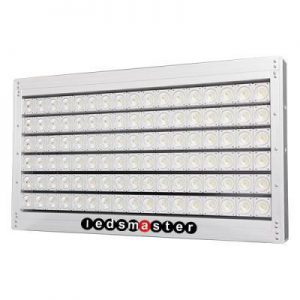 Conventional lighting fixtures (metal halide lamps, etc.) have concentrated and dazzling light, and the light is easily blocked by structures and other objects, resulting in limited lighting range. At the same time, the power of the fixture is large and easy to damage. Long-term use will cause serious waste of electricity, Easy to produce hidden dangers.
Conventional lighting fixtures (metal halide lamps, etc.) have concentrated and dazzling light, and the light is easily blocked by structures and other objects, resulting in limited lighting range. At the same time, the power of the fixture is large and easy to damage. Long-term use will cause serious waste of electricity, Easy to produce hidden dangers.
Sports experts are actively seeking new LED anti-glare lighting alternatives. After comparing sources, the use of new LED energy-saving light strips to replace conventional metal halide lighting fixtures has greatly improved the disadvantages of conventional lighting fixtures. The overall process is beautiful and the lighting effect is good. Greatly save the cost of construction electricity.
Under normal use conditions, the lighting LED energy-saving lamps have a long life, and the theoretical lighting time is nearly 87,600 hours, which is 10 to 15 times that of traditional lamps. And in the component material of the LED flexible light bar, whether it is LED or FPC, its material is environmentally friendly material, which is recyclable, and will not cause environmental pollution and damage due to large-scale use.
The successful replacement of LED energy-saving lamp belts has improved the quality of on-site lighting technology, reduced power waste, reduced material loss, and significant economic benefits.



